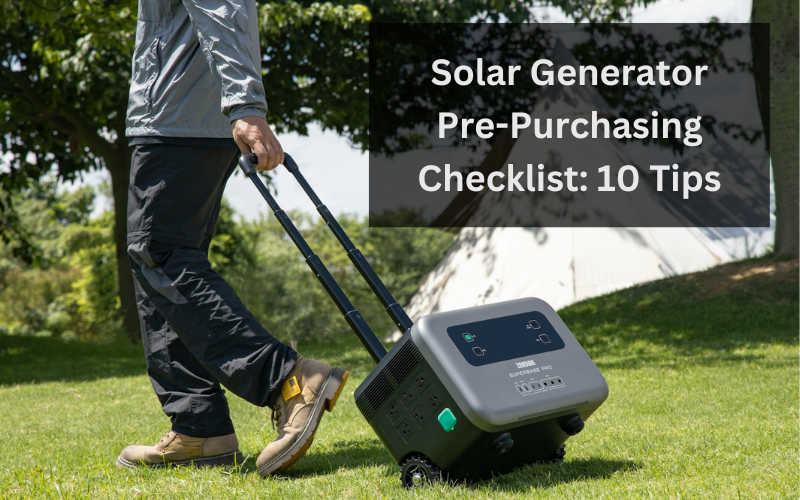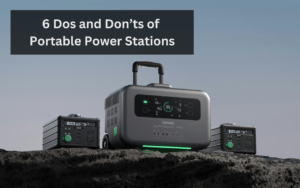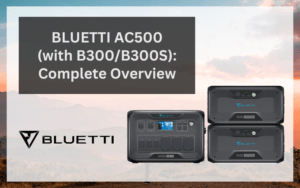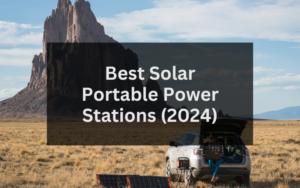Welcome to our complete guide on choosing the right solar generator. Written for anyone considering purchasing a new solar generator or portable power station, from outdoor enthusiasts to those seeking off-grid or emergency backup solutions, this article covers the essential factors to consider, like power requirements, portability, battery, durability, warranty, and ease of use.
Whether you’re planning to power a remote cabin, gear up for your next camping trip, or prepare for power outages, this solar generator pre-purchase checklist will help you to identify the best solar generator to meet your needs.
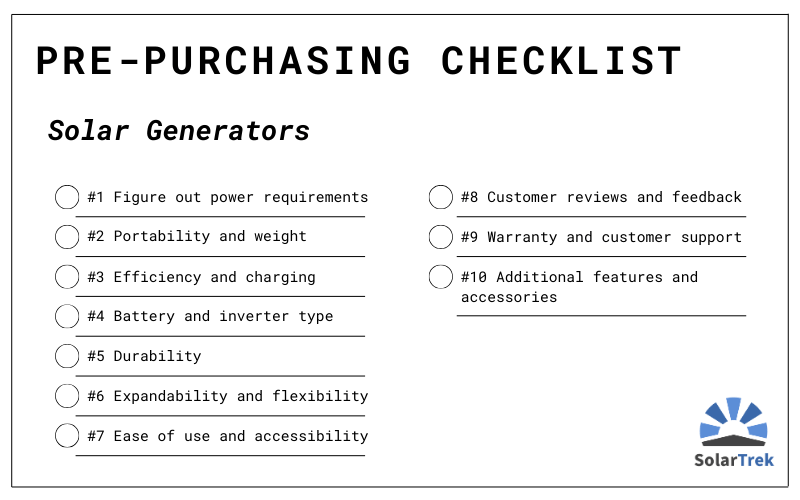
Table of Contents
1. Figure out your power requirements
The first thing you should do before investing in a solar generator is to determine the wattage and capacity that’s required to meet your specific needs. This step ensures that the generator you choose can handle the demands of your appliances and devices during usage without faltering. Here’s what you should look at:
- Calculate your total wattage requirement: Start by listing all the devices and appliances you plan to power with the solar generator. For each item, take a note the wattage, which is usually found on the device label or in the user manual. Add up these figures to get your total wattage requirement. This number is essential, as it guides you on the minimum output your solar generator should provide.
- Consider peak and continuous loads: Appliances like refrigerators and pumps often require more power to start up – known as starting or peak load – than they do to continue running. Ensure that the solar generator can handle these peak loads without tripping or shutting down. The generator’s peak capacity should be higher than your calculated peak load.
- Assess usage duration: How long you need the generator to run is equally important. If you need continuous power throughout the day or for multiple days, look for a generator with a high-capacity battery. Calculate the total energy consumption in watt-hours by multiplying the total wattage requirement by the number of hours the generator will be used between charges.
- Battery capacity: After determining how much energy you need in a day, check the battery capacity of the solar generator, usually measured in amp-hours (Ah) or watt-hours (Wh). Make sure the battery’s total capacity exceeds your daily energy usage to avoid running short of power.
2. Portability and weight
Another area to think about when purchasing a solar generator is its portability, which depends on a number of factors including weight, dimensions, and design. The good news is that most solar generators (perhaps with the exception of home backup systems or other more substantial units) are designed to be portable – hence why the inverter and battery unit that makes up the generator is referred to as a ‘portable power station’.
How portable you want your solar generator to be will depend on your desired use cases, for example, whether you plan to take it with you on hikes or camping trips, or if it’s mostly going to sit around inside and power household appliances. You should also consider whether portability is going to be a big factor if you plan to use your solar generator in emergency situations. Here’s a closer look at each factor to consider when it comes to generator portability:
- Generator size: The physical size of the solar generator affects how easily it can be stored and transported. Larger generators typically offer more power and extended run times but can be cumbersome to move and set up. If space is a constraint or you intend to use the generator in different locations, smaller, more compact models might be more suitable.
- Generator weight: Solar generators vary significantly in weight, influenced largely by their battery type and capacity. Lead-acid batteries, for example, tend to make generators heavier but are generally less expensive. Lithium-ion batteries are lighter and more efficient, but come at a higher cost. LiFePO4 batteries are the safest and most stable option, and have a much longer life cycle than Lithium-ion batteries, but are heavier. Assess whether you’ll be able to comfortably transport the generator without assistance. If not, consider models that feature handles, wheels, or both, which greatly enhance mobility.
- Design and ease of transportation: If the generator is needed for activities like camping, outdoor events, or job sites, think about how you will transport it. A heavier generator may require a vehicle with adequate carrying capacity, while a lighter model could be carried by hand or fitted into smaller spaces. It’s also worth looking at the design of the handles on the generator units, or seeing if the generator comes with wheels or a pulley (for example, a trolley with wheels is sometimes an optional add-on when purchasing a solar generator). This is true for both the power station unit as well as the solar panels you are going to use with it – for example, some portable solar panels have built-in handles, or come with a zip-up case for moving around.
3. Efficiency, charging options, and charging speed
The next item on our solar generator pre-purchase checklist is efficiency, charging options, and charging speed. These are some of the most important aspects to consider when selecting a solar generator, as they determine how quickly the unit can meet your energy needs, especially in urgent situations.
- Battery capacity: The capacity of the generator’s battery indicates how much energy it can store and for how long it can provide power without needing a recharge. Higher capacity batteries store more energy, which is beneficial for prolonged use. However, larger batteries can also mean longer charging times unless supplemented by substantial solar panel input or an additional external power source.
- Solar panel size: The size of the solar panels integrated with your generator significantly affects how much power they can generate. Larger panels will naturally capture more sunlight and produce more energy, leading to quicker battery charges. Consider the physical dimensions of the solar panels in relation to where you plan to use or store the generator to ensure a practical fit.
- Charging options: Most solar generators offer more than just solar as a charging option – the majority of models will offer charging by AC/wall, solar panels, and car. This availability of options depends on a number of factors like the design, brand, and capacity of your generator, so it’s always worth checking to make sure you get the right versatility of charging options for your needs. Also note that each charging option is associated with different charging speeds, e.g. AC will often be quicker than charging via solar panels.
- Charging speed: The rate at which the generator’s battery can be charged is influenced by the solar panel’s output and the quality of the solar charge controller. Look for generators that offer fast charging capabilities, which is going to be particularly important in emergency scenarios.
- Consider the environment: Solar charging speed can also vary depending on your geographic location and the typical weather conditions. Areas with higher sunlight exposure will naturally facilitate faster solar charging. In less sunny conditions, you might need a generator with a larger panel, or dual charging options (solar and AC) to ensure it charges efficiently.
4. Battery and inverter types
We have already touched briefly on this, but the type of battery and inverter your solar generator uses really does have a big impact, as they influence a number of factors like charging speed, lifespan, weight, and cost. Here’s a breakdown of the most common types of each and their implications:
Battery types
- Lead-acid batteries:
- ✅ Pros: Cost-effective and widely available. Suitable for larger systems where weight is not an issue.
- ❌ Cons: Heavier and bulkier, which may affect portability. They require regular maintenance and have a shorter lifespan compared to lithium-ion batteries. They also have a lower depth of discharge and slower charging times.
- Lithium-ion batteries:
- ✅ Pros: Lighter and more compact, making them ideal for portable solar generators. They offer a higher depth of discharge, longer lifespan, and faster charging capabilities.
- ❌ Cons: More expensive upfront than lead-acid batteries, but often justify their cost over the long term due to better performance and lower maintenance requirements.
- Lithium iron phosphate (also known as LiFePO4 or LFP) batteries:
- ✅ Pros: Known for their stability and safety, which reduces the risk of overheating and is more tolerant to full charge conditions. They have a significantly longer life cycle, maintaining a high capacity for more charges than standard lithium-ion batteries.
- ❌ Cons: Heavier and more expensive than standard lithium-ion batteries. While they offer enhanced safety and longevity, the initial investment and increased weight can be a drawback for some users.
Inverter types
Inverters are a critical component of solar generators, and serve the essential function of converting the direct current (DC) electricity generated by the solar panels into alternating current (AC) electricity. This conversion is vital as most household appliances and electronic devices operate on AC electricity.
Without an inverter, the energy produced by solar panels could not be effectively utilized in a typical home or office setting. Inverters also play a role in regulating the voltage to ensure it is suitable for these devices, enhancing both the safety and efficiency of the solar power system. Here are the types of inverter you might come across:
- Modified sine wave inverters:
- ✅ Pros: Less expensive and can adequately power basic household appliances and tools.
- ❌ Cons: They may cause issues with more sensitive electronic devices due to the less smooth waveform they produce. This can lead to a buzzing noise in audio devices, reduced efficiency in appliances, and potential long-term damage to sensitive electronics.
- Pure sine wave inverters:
- ✅ Pros: Produce a smooth wave that is equivalent to, or better than, the power supplied by utility companies. They are compatible with virtually all household appliances and are more efficient, particularly for devices like microwaves, TVs, and computers.
- ❌ Cons: More expensive than modified sine wave inverters but recommended for those who rely on a generator to power sensitive electronics or want to ensure optimal appliance functionality and longevity.
Pure sine wave inverters are generally recommended, no matter the battery type of your solar generator, to ensure smoother operation of your connected devices.
5. Durability and weather considerations
The durability and resistance of your solar generator to weather conditions does, of course, depend largely on your intended use case. For example, whether you plan to mostly confine your solar generator to indoor use, or whether you plan on taking it out on frequent hiking trips. It also depends on your general climate – do you live in an area with high levels or rainfall, or high levels of humidity?
These are important considerations, as some solar generators are built to be more environmentally durable, whilst others are only built for gentle, indoor use. Here are the key features to look for:
- Robust build quality: Choose a solar generator with a sturdy, durable casing that can protect its internal components from physical impacts and environmental stress. High-quality materials such as reinforced plastics or metal casings are optimal, as they offer better protection against bumps, drops, and other forms of mechanical stress.
- Weather resistance: If you plan to use your solar generator outdoors or in harsh environments, ensure that the solar generator is either weather-resistant or weatherproof. Look for models that specify protection against rain, dust, and extreme temperatures. Certifications like IP ratings (‘Ingress Protection’) can provide a clear indication of a unit’s level of resistance to environmental elements.
- Corrosion resistance: If you live near the coast or in a high-humidity area, the risk of corrosion increases. Opt for solar generators designed with corrosion-resistant materials or protective coatings to prevent rust and ensure longevity.
- Temperature tolerance: Solar generators must be able to operate efficiently across a range of temperatures. Check the manufacturer’s specified operating temperature range to ensure it matches your local climate conditions. Extreme cold or heat can affect battery performance and overall system efficiency, so it’s important to choose a generator that can handle your area’s temperature extremes.
- Ventilation system: Adequate ventilation helps prevent overheating, particularly during extended use or under high ambient temperatures. Check whether the solar generator has a well-designed ventilation system, like built-in cooling fans, that keeps air circulating around critical components like the battery and inverter.
- UV protection: Prolonged exposure to sunlight can degrade materials over time. Look for solar generators with UV-protected panels and casings to ensure that they don’t become brittle or discolored after exposure to the sun.
6. Expandability and flexibility
Another factor to consider is the expandability and flexibility of your solar generator. This is particularly important if you think your energy needs might increase in the future. Here are the key aspects to consider when it comes to scaling up your solar system:
- Expandable battery capacity: Some solar generators are designed with the ability to add additional battery units, for increasing storage capacity. This feature is especially important if you anticipate a future need for more power, as it allows you to extend the runtime of your generator without needing to invest in a completely new system.
- Additional solar panel inputs: Check whether the solar generator has the capability to connect extra solar panels. This is particularly important for those looking to increase their energy capture and reduce reliance on charging from the grid or other sources. More panels mean faster charging times and greater power availability, especially in less sunny conditions.
- Modular design: Some solar generators are built with a modular design, which enables easy integration of additional batteries or other power modules. This design allows for a customized setup that can grow with your needs, whether it’s adding capacity or functionality.
- Compatibility with other energy sources: Flexibility can also mean the ability to integrate with other energy sources. There are even some advanced solar generators that can connect to wind turbines, hydro power systems, or conventional generators. This hybrid approach can ensure power availability in a variety of conditions and locations.
- Smart management systems: For systems where expandability is key, or if you’re looking at entire home backup systems, having a smart management system can make scaling easier. These systems help manage load distribution, optimize charging and discharging, and overall ensure that the expanded system operates efficiently. They can also provide detailed monitoring, which is crucial for maintaining performance as the system grows.
7. Ease of use and accessibility
User experience and accessibility features are sometimes overlooked. However, they should still play a part in choosing a solar generator. After all, no matter how powerful your solar generator may be, who wants to spend hours struggling to set up a generator with a terrible, clunky design? What use are different power settings if they’re impossible to access? Here are some features to look for:
- Multiple charging ports: As mentioned earlier, many solar generators will offer a range of charging options. A solar generator with multiple ports allows you to charge various devices simultaneously. Look for models that include a variety of port types, such as USB, USB-C, AC outlets, and 12V car ports. This versatility ensures that you can power laptops, smartphones, and other essential devices all at once, making the generator more practical and efficient in diverse situations.
- Simultaneous charging and discharging: Check if the solar generator supports pass-through charging, allowing it to power devices while it charges. This ensures continuous power during extended use or emergencies, ensuring no interruption in device operation. For many buyers, this is an essential feature.
- Easy portability (e.g. with wheels): Solar generators can be heavy, particularly those with larger battery capacities. A model equipped with durable, easy-to-manoeuvre wheels can significantly enhance portability. This feature is especially valuable in emergency scenarios where you may need to move the generator between locations or use it in outdoor settings – but wheels may actually be a hindrance in some cases (e.g. if you plan on taking it with you on mountainous hikes!).
- Intuitive controls and display: A user-friendly interface with clear controls and an easy-to-read display helps manage your generator’s operation efficiently. Look for generators that feature LCD or LED displays showing vital information such as battery level, input/output wattage, and charging status. This transparency allows for better planning and management of your power resources.
- Remote monitoring and control: Some newer models of solar generator offer Wi-Fi or Bluetooth connectivity, enabling remote monitoring and control through a smartphone app. This technology allows you to check the status of your generator and manage its operation from a distance. Furthermore, some features (such as ‘extra quiet operation’) may only be accessible via smart phone. For some customers, this is a bonus, but for others, it’s actually a big annoyance – it depends on your preferences and lifestyle.
- Quick setup: A generator that is easy to set up and use right out of the box can make a ton of difference to overall user experience, especially for those who are less ‘technologically inclined’. This might take the form of quick-connect panels, simple ‘plug-and-play’ operation, or clear and comprehensive manuals.
8. Customer reviews and feedback
We cannot stress this point enough – you should always ensure that you check the customer reviews and feedback for any product before making a purchase. Customer reviews contain such a wealth of invaluable, honest insights on the product’s real-world performance, which you simply wouldn’t get from the brand’s product page alone. In fact, it’s such an important aspect of the pre-purchasing checklist that on Solar Trek, all of our product overviews includes a summary of key takeaways, pros, and cons as frequently mentioned by customers. Here are the key areas to look out for when reading customer reviews:
- Brand support and service: Reviews often reveal the truth about a brand’s customer service. They provide insights into how responsive and supportive the company is, especially when dealing with warranty claims or technical support.
- Delivery and setup: Feedback can highlight any issues with delivery timelines or the setup process, including packaging quality and ease of installation.
- Product reliability: Customers will often share their thoughts on the reliability of the solar generator in various conditions. This is crucial as it reflects the product’s durability over time, or in different environments.
- Practical applications: Reviews often detail how well the solar generator performs in different scenarios, such as during camping trips, in emergency power outages, or for daily use in off-grid living. This helps you assess whether a generator will meet your specific needs.
- User experience: You can learn about any operational quirks or features that are particularly useful or annoying. Customers often share their workarounds or tips for better use of the generator, which can be a big help should you have similar issues down the line.
- Honest opinions: Unlike promotional materials from the brand, which will naturally highlight the product’s strengths, customer reviews offer a balanced view, pointing out both positives and negatives based on actual usage.
As well as online forums (e.g. DIY Solar Forum), another excellent place to look for genuine customer feedback is on Instagram or X. All the big solar brands have profiles on Instagram, for example, and you can get a good sense of user experience and general sentiment by checking the comments sections of their posts.
9. Warranty and customer support
Number 9 on our solar generator pre-purchase checklist is product warranty and sales support. As with any high value or technical product, you should always check the warranty and manufactural support before purchasing to get a sense of the product’s reliability. This will save you a lot of stress and hassle should something not work the way it’s expected. Here are the key aspects to look out for:
- Length of warranty: Typically, solar generators come with a warranty that can range from one to five years. The length of the warranty often reflects the manufacturer’s confidence in their product, but can also vary based on battery type (and hence life cycles) and overall price. Look for a warranty that covers a significant period, ideally three years or more, to ensure that your investment is protected.
- Coverage details: Understand what the warranty covers. Does it include the battery, solar panels, and all electronic components? Some warranties might only cover certain parts of the generator or offer different periods of protection for different components. It’s also important to know what actions might void the warranty, such as improper use or unauthorized modifications (such as using batteries from another model or brand which isn’t compatible).
- Customer support services: Check out the manufacturer’s customer support services. Are they easily accessible via phone, email, or live chat? Good customer support should be responsive and helpful, providing clear information and troubleshooting assistance when needed.
- Availability of replacement parts: Check if the manufacturer provides easy access to replacement parts. A solar generator can be a long-term investment, and having readily available parts can extend its lifespan and enhance its value.
- Service agreements: Some manufacturers may offer service agreements that include regular maintenance, which can be particularly advantageous for more extensive or complex solar generator setups. These services can help ensure your system operates optimally and can prevent future problems.
- Return policy: In case the solar generator does not meet your expectations or has defects, a good return policy will allow you to return the product without significant hassle or additional cost.
- User reviews and feedback: As mentioned earlier, you should always check user reviews and feedback to get a sense of the generator’s reliability and the company’s customer support. User experiences can give you insight into how warranty claims are handled and how supportive the company is in real-world scenarios.
10. Additional features and accessories
Some solar generators will come with additional features or optional accessories which might set the product apart from its competitors. These extras may provide greater convenience, extend the usability of the generator, or even make it suitable for a broader range of applications. Here are some useful additional features and accessories to look out for:
- Solar panels included: Most solar generators will come with solar panels included, but you may need to specify what quantity and what power. If you want to just purchase the battery/inverter unit without panels – for example, if you already own compatible panels – you should look at the ‘portable power station’ equivalent of that model. But if you don’t have panels yet, it’s recommended to purchase the full ‘solar generator’ set of portable power station plus panels, as this ensures the panels are compatible, and it’s generally the more cost-effective option.
- Expandable solar inputs: Look for generators that allow for the addition of extra solar panels. This feature is particularly useful if you might need to increase power generation capacity in the future to accommodate additional appliances or extended usage.
- Operation noise levels: Some generators come with different settings, including a ‘silent’ or ‘extra quiet’ mode which is typically associated with lower outputs. Noise levels might not be big deal to some customers, but if you plan on using your solar generator whilst you sleep or on campsites, a lower noise settings can be a highly beneficial feature to look out for.
- Built-in LED lights: For generators intended for use in camping or emergency situations, built-in LED lights can be extremely useful. They provide essential lighting without needing to use separate devices, saving other outlets for more critical needs.
- Interchangeable batteries: Some models offer interchangeable batteries, allowing you to swap out depleted batteries for charged ones quickly. This can be particularly useful in situations where you need continuous power without downtime for recharging.
- Smart displays and monitoring: Newer and more advanced solar generators may feature smart displays that provide real-time data on power usage, battery charge levels, and solar input. Some units also include monitoring apps that let you track and control the generator remotely via a smartphone. Consider whether this will be a help or a hindrance for your use cases.
- Multiple charging options: In addition to solar charging, some generators may offer alternative charging options such as AC outlets, car chargers, or even wind turbines. This flexibility can ensure you have power even when sunlight is insufficient.
- Weatherproofing: For outdoor use, particularly in harsh conditions, weatherproofing features such as water-resistance or waterproof design may be essential.
- Portable cases and covers: Some generators come with durable carrying cases or covers which protect the generator from dust and damage during transportation or storage. They are especially useful for keeping the generator protected when used outdoors.
- Accessory kits: Some generators come with accessory kits that include adapters, connectors, and additional cables. These kits can enhance versatility and ensure you have all the necessary components to meet your power needs right out of the box.
Conclusion
Selecting the right solar generator involves considering several key factors, including power needs, portability, battery and inverter types, durability, and ease of use. We maintain that reading the customer reviews and feedback of different models is the best way of getting unbiased, genuine insights that will help you make an informed decision. For this reason, the articles we post here on Solar Trek contain a detailed breakdown of customer feedback for each product we look at.
We hope you found this solar generator pre-purchase checklist helpful, and we will continue to post tips and guidance on selecting solar generators to make your purchasing experience that much easier!
Solar Trek is all about breaking down information about solar-powered brands and products into a helpful, easily digestible format. All of our content is totally objective, aimed at helping you to make the best purchasing decisions for your solar needs. If you click our links and make a purchase, we may earn some commission at absolutely no extra cost to you, but this does not interfere with our goals of providing 100% helpful, informative, and objective information.


